Categories
- Argentina
- Chile
- Antarctica
- Easter Island
- Falklands (Malvinas)
- Bolivia
- Peru
- Uruguay
- Paraguay
- Brazil
- Venezuela
- Colombia
- Ecuador
- Galapagos
- Panama
- Costa Rica
- Cuba
- Nicaragua
- Honduras
- El Salvador
- Guatemala
- Belize
- Mexico
- Latin American Xmas
Pages
- Map of South America
- Home Page
- First week in Latin America – October 2009
- Map of Central America
- Contact Us
- The Jesuit Missions in South America
- A week in Buenos Aires
- Street Art of Buenos Aires
Archives
- October 2011 (3)
- September 2011 (9)
- August 2011 (10)
- July 2011 (7)
- June 2011 (6)
- May 2011 (11)
- April 2011 (10)
- March 2011 (4)
- February 2011 (5)
- January 2011 (6)
- December 2010 (6)
- November 2010 (4)
- October 2010 (8)
- September 2010 (5)
- August 2010 (7)
- July 2010 (5)
- June 2010 (6)
- May 2010 (6)
- April 2010 (7)
- March 2010 (6)
- February 2010 (9)
- January 2010 (4)
- December 2009 (8)
- November 2009 (5)
- October 2009 (2)
Southern Brazil
27th September 2010
After a week´s R&R in Florida visiting family, we were ready for Brazil. Crossing from Santo Tomé [1] in Argentina by local bus we arrived in São Borja [2] only to find we had not legally entered Brazil so it was back to the border in a taxi for the entry stamp, thus missing our bus and spending the day at the rodovíaria (bus station). Then the afternoon bus was stopped by the police for 45 minutes so we missed the last bus to São Miguel, but we spent two nights in Santo Anglo [3]. There is a modern replica of the São Miguel church. Not understanding Portuguese, we feel frustrated.
.
The small village of São Miguel das Missões [4] has the best preserved of the Brazilian Jesuit missions, São Miguel Arcanjo, which is a Unesco World Heritage site. This is gaucho territory. Men sporting the traditional wide brimmed hats, knee high boots and bloomers are a common sight.
.
Bento Gonçalves [5], first settled by Germans and later Italians is the centre of wine production in Brazil. In nearby Vale dos Vinhedos steepled churches and stone farmhouses stand out amongst rows of grape vines. With a glass of cheap local wine in our hands at 0830 am we boarded the Maria Fumaça (Smoking Mary) steam train that runs between Bento Gonçalves and Carlos Barbosa. On the way it stops Garibaldi for the passengers to alight and partake in cheap sparkling wine, all the while being entertained by loud Italian music.
.
To break a long bus journey we spent a night at Porto Alegre [6], on the banks of the huge freshwater Lagoa dos Pato. It has a bustling public market selling all kinds of delicious looking produce.
.
Click on the numbers above to see where the places are on the map.
.

- The ruins of Sáo Miguel Arcanjo

Inside the church

Back of the church

Stautues from inside the church

Fountain

The church at Santo Ängelo is a replica of the Sáo Miguel church



Guarani family
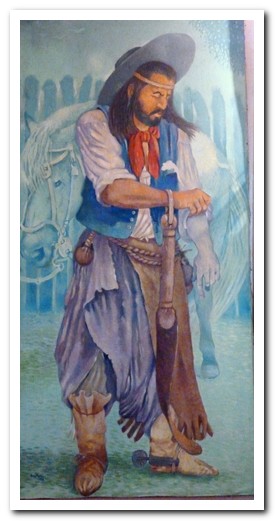
Brazilian gaucho

The wood fired Maria Fumaça enroute

Smoking Mary

Vineyards in Vale dos Vinhedos
Florianópolis & Curitiba
02nd October 2010
Florianópolis [7] on Brazil´s southern coast is the gateway to Santa Catarina Island. In the historical centre of the city is a well preserved colonial church from 1750, the Igreja de Nossa Senhora do Rosário as well as a former governor´s palace.
.
Ilha de Santa Catarina has some beautiful beaches and tiny fishing villages where fishermen of Azorian descent still make a living from the sea. We began in the southern part of the island with a hike to the picturesque lighthouse of Praia dos Naufragados followed by feed of succulent oysters on the dock at Ostradamus in the fishing village of Ribeirao da Ilha. Fishing boats dot the beach at Pantano do Sul on the island´s south east coast. There is a lovely walk partway around Lagoa de Conceição from the town of Lagoa.
.
Curitiba [8] lies inland at about 900 metres above sea level. It has a small, pedestrian only, cobble stoned old centre with beautifully restored buildings. Every day since 1885 the Serra Verde Express train click clacks down the jungle covered mountain to the tiny village of Morretes on the banks of the Rio Nhundiaquara. The culinary specialtyhere is barreado, a rib-sticking meat stew cooked in a clay pot.
.
Click on the numbers above to see where the places are on the map.
.

Colonial palace in Floripa

Church from1750 in Floripa

Floripa´s central market

Santa Catarina Lighthouse

Bird fishing

On the beach



Mural of the Portuguese church at Ribeirao da Ilha

Biggest and best oysters since Knysna (South Africa)

Fishing boats

Church at Lagoa

Around the lake

Portuguese church in Curitiba

Black and white paving in Curitiba reminds us of Lisbon

Curitiba

Train to Morretes descends through the jungle

Strange looking arcania pines

Marumbí train station
Rio de Janeiro
06th October 2010
The city of Rio de Janeiro [9] (January River), known as Cidade Maravilhosa (Marvellous City), sits amidst rainforest covered mountains and is surrounded by white sand beaches. The French first settled here in 1555 but the Portuguese took over in 1567.
.
We stayed in the pretty blue and white Hotel Santa Clara on a quiet back street a short walk from Copacabana Beach, a good place for running, long strolls and people watching. Too bad the weather was ugly so there were no bare cheeked Brazilian bodies on the beach.
.
A cog train carries people up Corcovado Mountain through lush jungle to visit the 38 metre high, open armed statue of Christ the Redeemer. Views from the top are spectacular on a clear day. We were not so lucky, but next day we had great views of the city from atop Sugarloaf Mountain, reached by cable car. The city centre still has some colonial buildings amongst the sky scrapers.
.
A freshly blended fruit juice was a daily must and we enjoyed the buffet meals charged by the kilo thus not only avoiding a pig out, but a rare opportunity to eat vegetables.
.
Cidade Maravilhosa really is marvellous – the beaches, the jungle; the old, the new; the rich, the poor; the luxury, the squalor. It is one of our favourite cities.
.

Statue of Christ the Redeemer high above Rio

The statue in the clouds

Looking down at Sugarloaf mountain

A clear view of Botafugo

Copacabana beach deserted

Copacabana Beach on a brighter day

Shanty towns climb up the hill sides of Rio

Colonial church

Formerly one of the richest Churches in Brazil

The old and the new



Ipanema Beach at dusk
Paraty
07th October 2010
Paraty [10] , south of Río, is a colonial gem on a quiet bay where jungle meets the ocean. The first Portuguese arrived at the end of the 16th century. It became an important port for shipping gold back to Portugal, but fell into decline and a lack of roads helped preserve its constructions, culture and traditions. The cobbled streets, closed to traffic, are lined with centuries old buildings.
.
Three historic churches in Paraty lie within close proximity – one for each race.
.

Capela de Nossa Senhora das Dores, 1800, for the elite whites

Igreja de Santa Rita, 1722, for the mullatos and freed slaves

Igreja de Nossa Senhora Rosário, 1725, for the slaves

A Paraty street

Across the river

High tide covers the street in front of the fish market

Colourful fishing boats

Reflection on the river

Anyone for a cold coconut?
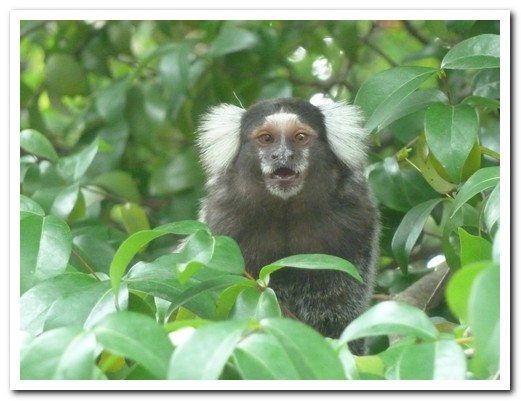
Small monkey in the trees in town

Typical dish – fish cooked in coconut milk tomato and banana – delicious
Ouro Preto
10th October 2010
Northwest of Rio, one of Brazil´s most beautifully preserved towns, Ouro Preto (Black Gold) [11] occupies several hills with its churches towering over their surroundings. Gold was discovered here in 1690 and a village arose in 1711, rapidly growing to become the capital City of the Province of Minas Gerais with a black slave population of 100,000. After independence from Portugal, a new Capital was built 100 kilometers away at Belo Horizonte. Ouro Preto continued untouched by the 20th century and today remains an 18th century Portuguese town. A surprise awaited us around every bend in the steep winding cobbled streets.
.
We suspected something might be going on when we found the line for the bus from Belo Horizonte [12] was over 100 meters long. Luckily, being over 60, we had priority! It turned out a 4 day party leads up to October 12, drawing great crowds (think students and beer) to celebrate the Mining School of the Universidade Federal de Ouro Preto opening its doors on 12 October 1876. We got the last bed in town at the friendly and quiet Pousada Ouro Preto. The smell of grilling meat led us to a small outdoor diner opposite the Church of San Francisco for a couple of alfresco beers and kebabs.
.
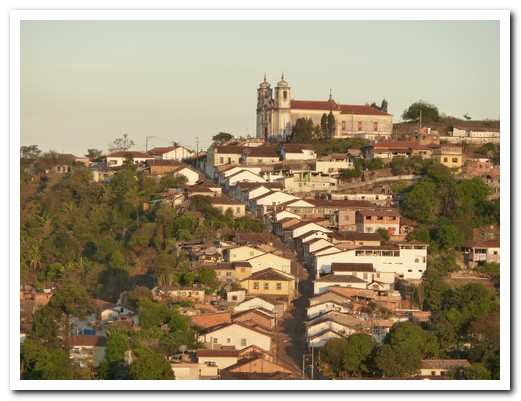
Winding street leading up to the slave church

Church built by and for the slaves




Ouro Preto street
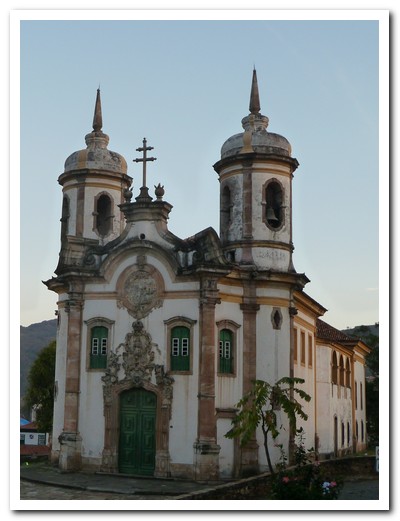



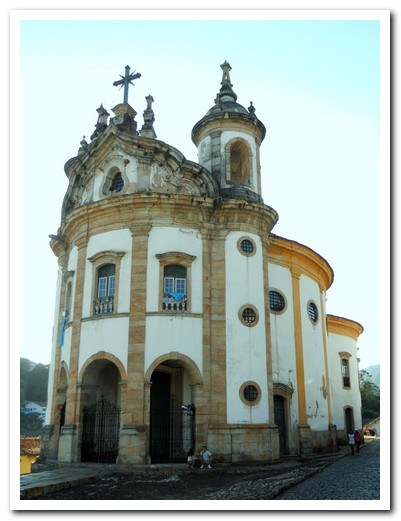


The old Governor´s Palace

Twisting Ouro Preto street


One of the many fountains

The Bridge of Sighs (1755)
Salvador
13th October 2010
We flew in to Salvador [13] to avoid a 24 hour bus trip as we are finding the Brazilian buses more like amusement park rides. Nega Maluca (crazy black woman) Guesthouse, just outside the Pelourinho where slaves were auctioned, was warm and welcoming plus served fresh pancakes for breakfast.
.
Salvador, on beautiful Bahia de Todos os Santos, was Brazil´s first capital from 1549 and second only to Lisbon in importance to the Portuguese empire. Millions of African slaves were brought to the city in mid the 1500s and today their heritage is alive and flourishing in food, music, dance, religion and the practice of capoeira, a form of martial arts.
.
The vibrant historical centre in the upper part of the city has a wealth of crumbling 17th and 18th century buildings including many beautiful churches. Brightly dressed women lure tourists into the many souvenir shops. A 10 minute bus ride south bought us to the Farol da Barra, South America´s oldest light house, and 3 colonial forts. On the beach we snacked on cheese cooked over charcoal by a singing cheese griller.
.

Salvador´s old heart

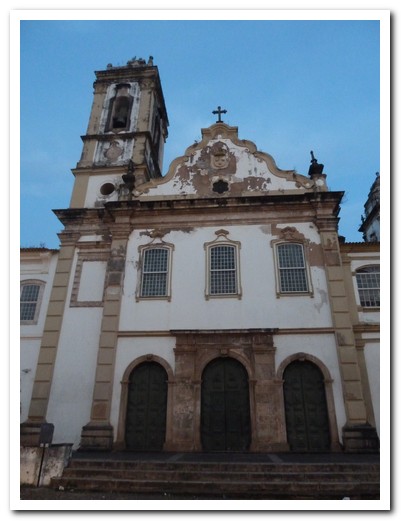

Three colourful local ladies

Packed in buildings lead up to the Carmelite Convent


Watching life go by

Local musical instrument

Port of Salvador

Fort in the Harbour

Restored buildings in the upper town (Pelourinho)

Tiled marker in the middle of the road

Wave pattern in the footpath leading to the Cathedral

Church steeples above the roof tops



Hill top church at Barra

Portuguese fort at Barra

Oldest lighthouse in South America

Beach at Barra

Northern Beaches
17th October 2010
Stretching around the north eastern coastline of Brazil is a thousand kilometres of beautiful palm fringed beaches. The weather is warm enough to swim now, the clear blue water inviting, so our bathers have been moved up to the top of our packs.
.
On the beachfront at Maceio [14] we enjoyed a balmy evening breeze while sampling a local speciality of tapioca and coconut pancakes filled with chicken from one of the thatched roofed tapioca stands. There is also a sweet filling of cinnamon and sugar which is equally delicious. Brightly coloured fishing boats line the beach in front of the fish market.
.
Picturesque Olinda [15] is another colonial classic with twisting cobbled streets lined with brightly coloured buildings. The city, dating from 1535, was sacked by the Dutch in 1631, but later rebuilt. We arrived in the evening to find a crowd gathered in the narrow street outside our posada. Relieved that it was just locals gathered around outside a small shop (Bodega do Véia) selling ice cold beer and enjoying the sounds of a few musicians, we bought a beer, sat on the sidewalk and joined in.
.
Natal [16] is surrounded by huge sand dunes with a popular beach at Ponta Negra stretching around the bay.
.

Dawn at Maceió

Maceió fishing boats

Fish market

Maceió beach

Colourful Olinda

Olinda Monastery

An old monk at the Monastery

Olina street by the beach

One of Olinda´s Portuguese churches

Convent at Olinda

Hill top church - Olinda

Music everywhere

Saturday afternoon warm up at Bodega do Véio

Olinda speciality - pumpkim stuffed with coconut prawns

Sunday afternoon at Ponta Negra

Barbecue carts ply the beach

Anyone for grilled cheese?
Belém
20th October 2010
Hot and steamy Belém [17] sits at the mouth of the Amazon River 150 kilometres south of the Equator, its streets lined with huge old shady mango trees. Interesting historical buildings remain as well as the 1616 fort which once guarded the river entrance. The busy waterfront market sells everything including exotic Amazon fruit and Brazil nuts. Boats unload fish and prawns while pigs lie squealing on the docks.
.
After meeting up with Eduardo and Mervyn we were privileged to attend Ed´s grandparent’s 60th wedding anniversary celebrations.
.
We purchased passage on the N/M Rondonia headed up river two and a half days to Santarem [18]. Stay tuned…
.

Belém Cathedral


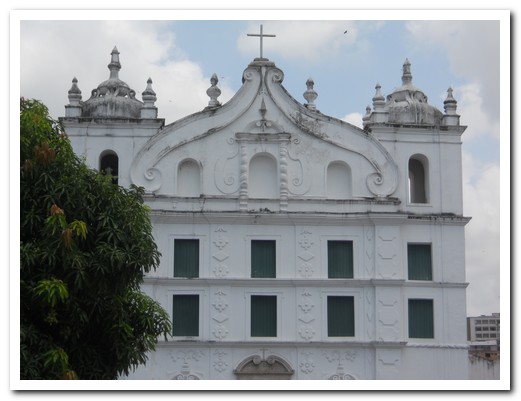
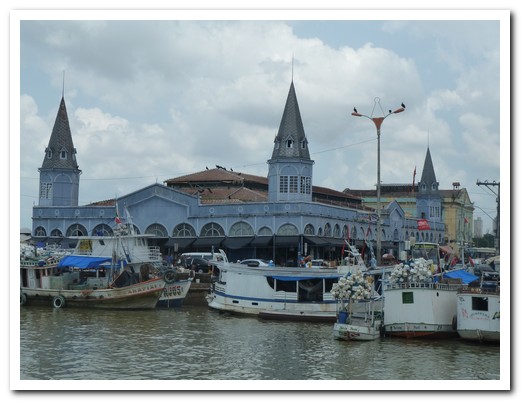
Riverside market

Fish sold off the boats

Jeff, Merv & Ed enjoy a fresh coconut juice

Exotic Amazon fruits

Get your Brazil nuts here

Harbour full of boats

Convoy heading up the Amazon
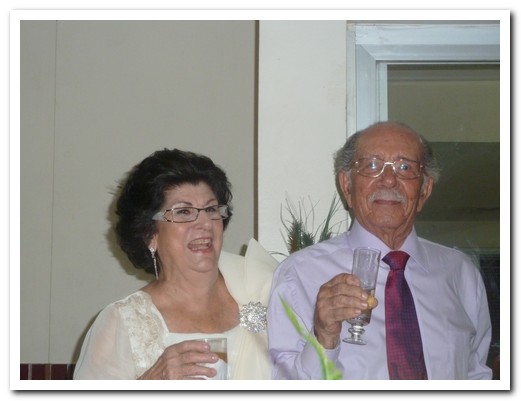
The Cabrals celebrating 60 years of marriage
The Amazon – Belém to Santarém
26th October 2010
We boarded our Amazon boat, the Rondonia, two hours before the scheduled 6 pm departure. Already many people had hung their hammocks in the prime positions on the covered decks. We opened a bottle of Brazilian red to share with Ed and Merv while watching Belém [17] slip away in the dusk, but truck after truck full of produce kept arriving to be loaded aboard slowly by hand and after the second bottle of wine we gave up and went to bed. The boat finally departed at 1 am. Rumour has it that after the inspectors have gone more cargo is loaded on.
.
Although the river is massive, there are many islands and numerous boats of all sizes ply the Amazon. Our boat, music constantly blaring from the ship´s loud speakers, stayed close to the banks allowing us to spend a couple of pleasant days passing little communities along the banks. Villagers row out in small boats to collect the floating parcels of used clothes hurled from the ship by kind passengers who travel up and down regularly. Occasionally we would spot some river dolphins.
.
After the boat docked in Santarém [18], we hopped on a packed local bus to Alter-do-Chão [19], an idyllic little village with a white sandy beach and clear green water, almost a 1000 kilometres from the sea. Waiters wade out to serve people sitting at tables in the tepid water. Children walk the beach selling bags of homemade banana chips. For lunch, we went for a whole, freshly grilled fish from a thatched roof beach shack. That evening, after a few Caipirinhas (cocktail of Cachaça rum, crushed lime and sugar), Ed introduced us to food from his early days in Brazil – Tacaca, a prawn soup served in a half coconut shell bowl.
.
After 3 days, we said goodbye to Ed and Merv and headed back to Santarém for our boat to Manaus [20], another two days further up the Amazon.
.

Hammocks packed like sardines on the boat to Santarém
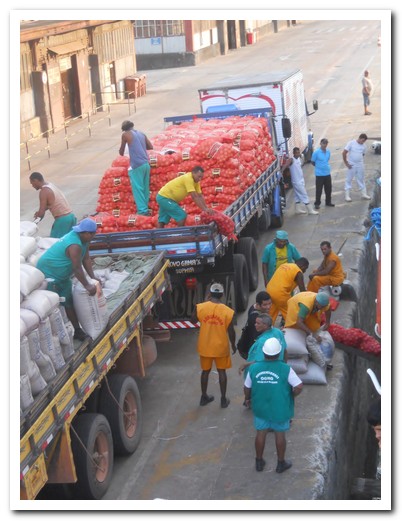
The boat can´t go till the onions are loaded

One of the boats we passed on the Amazon

Village houses
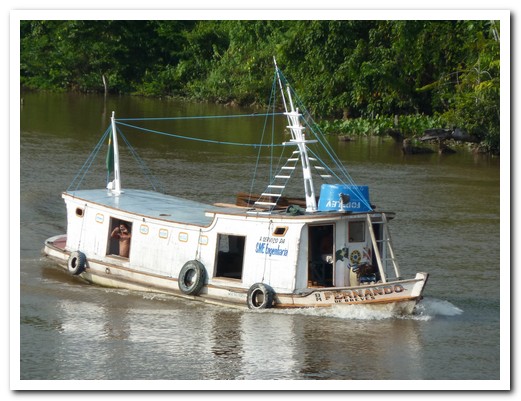
There are boats of all sizes
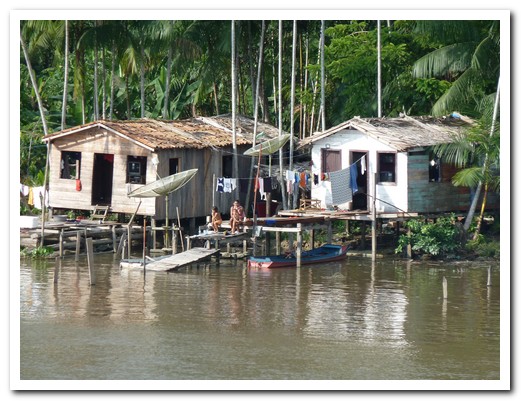
More houses over the water

The family out to greet the weekly boat

They start young

Pretty casual on the bridge (love the adjustable chair)

On the boat with Merv and Ed
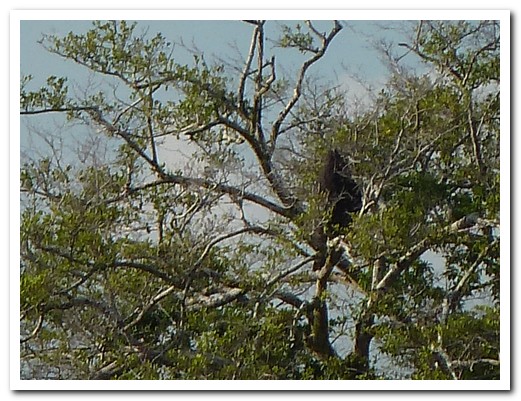
It´s a sloth!

Passengers waiting on the dock

Amazon sunset

Full moon over the river

Sunrise reflected

Santarém

Disembarking

Loaded up waiting for the bus
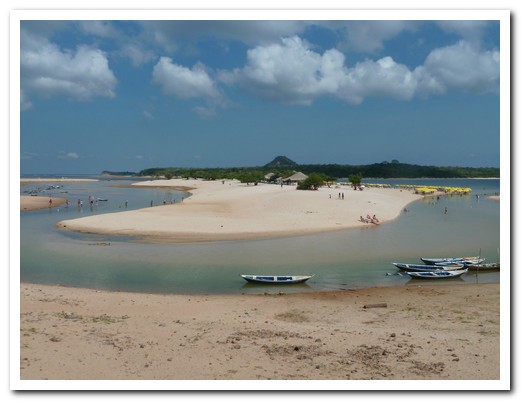
Beautiful Alter-do-Chão
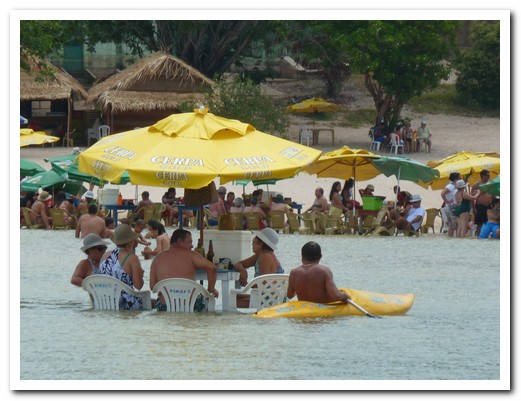
Brazilians at the beach on a sunny day

.... and a rainy day
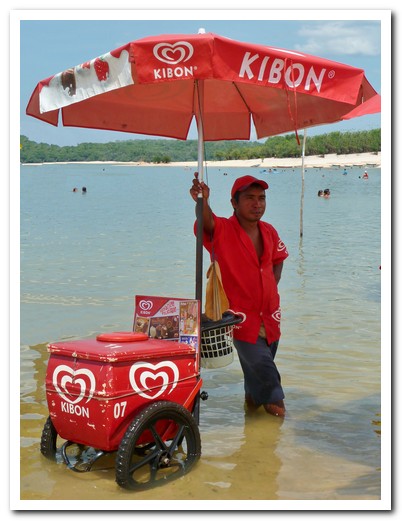
Ice cream anyone?

Tacaca sold from a beach stall

Pretty bird admires his reflection

A cashew nut - the trees line the waterfront

Phone booth

Small monkey
